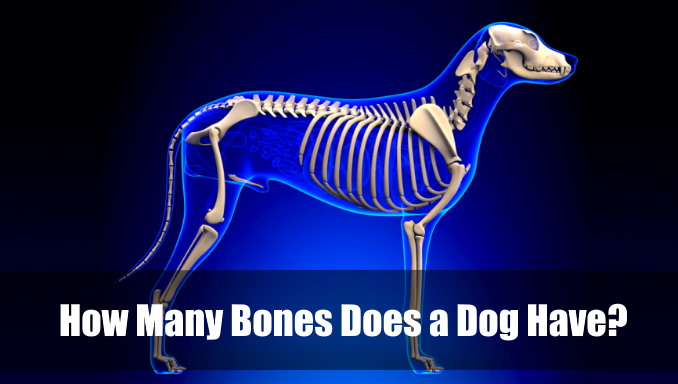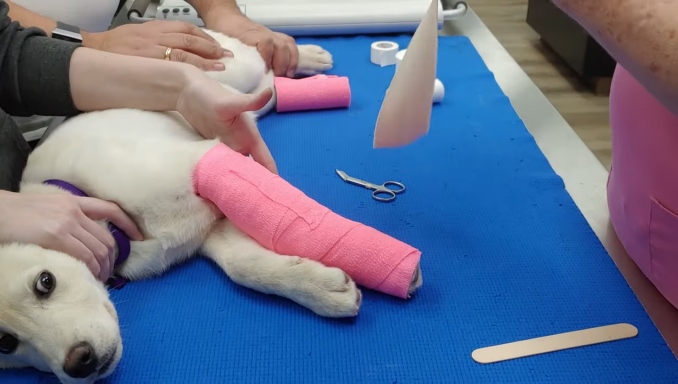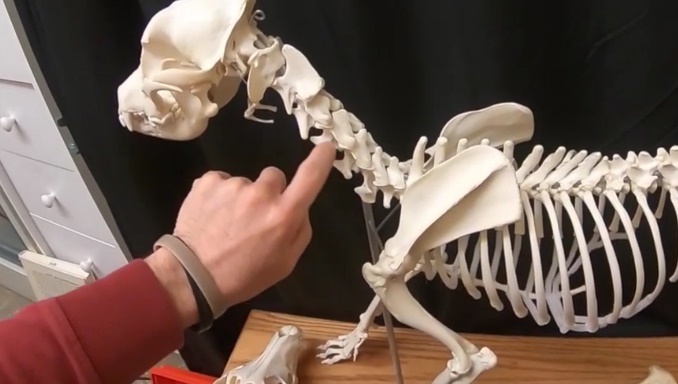How Many Bones Does a Dog Have?
Dogs are known for being affectionate, loyal companions. But what most pet owners may not know is that dogs have many similarities to humans when it comes to their skeletal systems. In this blog post “How many bones does a dog have?”, we will take a closer look at the number of bones in a dog’s body and how they compare to humans.
We will also explore some of the reasons why having strong bones is important for both species. So, whether you’re a dog lover or just interested in learning more about these furry creatures, keep reading!
How Many Bones Does a Dog Have?
How many bones does a dog have? Dogs have more bones than humans do. While an adult human has 206 bones, an adult dog has 319 bones. The extra bones in a dog’s skeleton are found in their tail and their legs. Dogs also have more joints than humans. This is because they are quadrupedal, meaning that they walk on all fours. Their extra joints allow them to move their legs in a way that allows them to run and jump.
The number of bones in a dog’s skeleton is important for several reasons. First, the more bones there are, the stronger the skeleton is. This is important for both dogs and humans because it helps to protect our internal organs from injury. Second, the extra bones in a dog’s skeleton give them more leverage when they run and jump. This helps them to move more quickly and agilely. Finally, the additional bones help to support the dog’s weight.
While dogs have more bones than humans, it is important to remember that they are not indestructible. Bones can break, just like in humans. It is important to take care of your dog’s skeleton by feeding them a balanced diet and ensuring that they get enough exercise. This will help to keep their bones healthy and strong throughout their lifetime.
Do all dogs have the same skeleton?
No, not all dogs have the same skeleton. The number of bones in a dog’s skeleton can vary depending on the breed of the dog. For example, small breeds of dogs usually have fewer bones than large breeds. This is because they have smaller bodies and therefore need fewer bones to support their weight.
The size of a dog’s skeleton can also vary depending on whether the dog is male or female. Male dogs tend to have larger skeletons than females. This is because they are usually bigger and heavier than females.
Finally, the age of a dog can also affect the number of bones in their skeleton. Puppies have more bones than adult dogs because they are still growing and developing. As puppies grow and their bones fuse together, they end up with fewer bones than they started with.
The Skeletal System of the Dog
Now you know more about How Many Bones Does a Dog Have?. But what exactly are these bones made up of? The skeletal system of the dog is made up of two main types of tissue: bone and cartilage.
The skeletal system is made up of bones, joints, and ligaments. The bones provide support and protection for the body, while the joints allow for movement. The ligaments connect the bones to each other and help to stabilize the joint.
Dogs have a variety of different types of bones in their bodies. These include long bones, short bones, flat bones, and irregular bones. The long bones are found in the legs and provide support for the body. The short bones are found in the hands and feet and provide stability. The flat bones are found in the ribs and protect the internal organs. The irregular bones are found in the spine and help to support the weight of the body.
Dogs also have a variety of different types of joints in their bodies. These include ball-and-socket joints, hinge joints, and gliding joints. Ball-and-socket joints allow for a wide range of motion, while hinge joints allow for back-and-forth movement. Gliding joints allow for side-to-side movement.
The skeletal system is important for both dogs and humans because it provides support and protection for the body. Without bones, we would be unable to move or even stand upright. The skeletal system also helps to protect our internal organs from injury.
Bones are living tissue that is constantly growing and changing. They are made up of minerals, such as calcium, and living cells. The cells in bones are constantly renewing themselves, which helps to keep the bone strong.
There are two types of bone cells: osteocytes and osteoblasts. Osteocytes are mature bone cells that help to maintain the bone. Osteoblasts are young bone cells that help to build new bone.
Bone growth occurs when the osteoblasts create new bone and the osteocytes help to maintain it. This process is known as remodeling. Remodeling is a continuous process that happens throughout our lives. It helps to repair any damage that may have occurred to the bone and also helps to keep the bone strong.
The Dog’s Muscular System
How many bones does a dog have? 320 but is responsible for the movement of the body. The muscles are attached to the bones and work in pairs to move the joints. There are three types of muscle tissue: skeletal, smooth, and cardiac.
Skeletal muscle tissue is responsible for moving the voluntary muscles, such as those in the arms and legs. This type of muscle tissue is under conscious control, which means we can choose to move it or not.
Smooth muscle tissue is responsible for moving the involuntary muscles, such as those in the digestive system. This type of muscle tissue is not under conscious control and works automatically.
Cardiac muscle tissue is responsible for moving the heart. This type of muscle tissue is also not under conscious control and works automatically.
The dog’s nervous system is responsible for sending signals to the muscles telling them when to move. The nervous system is made up of the brain, the spinal cord, and nerves.
The brain is responsible for processing information and sending signals to the muscles. The spinal cord is responsible for sending signals to the muscles from the brain. The nerves are responsible for sending signals to the spinal cord from the brain.
Dog skin system
The skin is the largest organ in the body and plays a very important role. The skin protects the body from infection, helps to regulate body temperature, and helps to produce vitamin D.
The skin is made up of three layers: the epidermis, the dermis, and the subcutaneous layer. The epidermis is the outermost layer of the skin and is made up of dead skin cells. The dermis is the middle layer of the skin and is made up of living tissue. The subcutaneous layer is the innermost layer of the skin and is made up of fat and connective tissue.
The skin is constantly renewing itself. Dead skin cells are shed from the body and new ones are produced to take their place.
The skin also contains sweat glands, which help to regulate body temperature. Sweat is produced when the body is too hot and evaporates on the surface of the skin, cooling the body down.
The skin also contains oil glands, which help to keep the skin healthy and moisturized.
The hair on the skin also plays a role in protecting the body. The hair helps to trap dirt and bacteria and keeps them from entering the body.
Why do dogs molt in winter?
Dogs molt in winter because they need to get rid of their old coat and grow a new one that is thicker and will protect them from the cold weather. The new coat usually starts to grow in late fall and is fully grown by early winter.
What Are the Main Functions of Bones?
Besides how many bones does a dog have, bones play a number of important roles in the body. They provide structure and support, help to protect our internal organs, and allow us to move. Additionally, bones store minerals such as calcium and phosphorus, which are essential for maintaining strong bones.
Bones are made up of living tissue, which means that they are constantly growing and changing. During childhood and adolescence, bones grow in size and density. This process slows down in adulthood, but bones still undergo remodeling throughout life. This means that they are constantly being broken down and rebuilt.
While bones provide a number of important functions, they can also be susceptible to injury. Bones can break, or fracture, when they are subjected to more force than they can handle. This can happen due to a fall, a car accident, or even just by landing on the ground too hard. When a bone fractures, it is important to seek medical attention so that the bone can be properly set and heal correctly.
Why does the structure of dog bones help them run faster than humans?
One of the reasons that dogs are able to run faster than humans is because of the structure of their bones. Dogs have longer legs relative to their body size, which gives them a longer stride. Additionally, their bones are lighter and more flexible than human bones, which makes them better able to absorb the impact of running. Finally, dogs have a higher percentage of fast-twitch muscle fibers, which allows them to generate more power when running. All of these factors combine to make dogs faster runners than humans.
Why Are Strong Bones Important for Dogs?
Strong bones are important for dogs for many of the same reasons that they are important for humans. Bones provide support and protection for our internal organs. They also help us to move by providing leverage for our muscles.
In addition, strong bones are important for dogs because they help to keep them healthy and active. Dogs with weak or fragile bones are more likely to suffer from injuries. They may also have difficulty moving around and may be more prone to arthritis.
Finally, strong bones are important because they help dogs to live longer, healthier lives. Dogs with weak bones are more likely to suffer from bone diseases such as osteoporosis. This can lead to pain, disability, and even death.
What Are Some Common Problems That Can Affect a Dog’s Skeleton?
Do you need to know how many bones does a dog have to know that. There are several common problems that can affect a dog’s skeleton. These include bone diseases such as osteoporosis, joint problems such as arthritis, and injuries such as fractures.
Osteoporosis is a condition in which the bones become weak and fragile. It can lead to pain, disability, and even death.
Arthritis is a condition that causes inflammation and pain in the joints. It can make it difficult for dogs to move around and may eventually lead to joint damage.
Finally, fractures are breaks in the bones. They can occur due to trauma or from weak or fragile bones. Fractures can be very painful and may require surgery to heal properly.
How Can I Tell If My Dog Has a Problem with Their Skeleton?
There are several signs that you can look for to tell if your dog has a problem with their skeleton. These include limping, stiffness, joint pain, and difficulty moving. If you notice any of these signs, you should take your dog to the veterinarian for an examination.
X-rays and other imaging tests can be used to diagnose problems with the skeleton. The veterinarian may also recommend blood tests or other laboratory tests to rule out other conditions.
Treatment for problems with the skeleton will vary depending on the cause. Treatment may include medication, surgery, or other therapies.
Although dog bone problems do not affect how many bones does a dog have but the structure and make up of the bones are different from that of humans. For example, a dog’s femur is not attached to the hip socket like ours but rather is attached by a muscle. This gives dogs more range of motion at the hip joint which helps when they run. Also, dogs have more bones in their feet than we do which helps them distribute their weight evenly and helps them run faster.
How to deal when a dog has a broken bone
If your dog has a broken bone, it is important to seek medical attention as soon as possible. The veterinarian will likely recommend x-rays to determine the type and location of the fracture. Treatment will vary depending on the type of fracture, but may include splinting, casting, or surgery.
It is important to follow the veterinarian’s instructions for care and to keep your dog calm and quiet during the healing process. This will help to ensure that the bone heals correctly.
Once the bone has healed, your dog will likely need physical therapy to help them regain strength and mobility. This may include exercises, massage, and other therapies.
How to Care for Your Dog if They Have a Broken Bone
- If your dog has a broken bone, it is important to get them medical attention as soon as possible. Once you have taken your dog to the vet, there are some things you can do at home to help them heal and feel comfortable.
- Give your dog the prescribed medication. This will help with pain and inflammation.
- Rest is important for your dog. They may need to stay in a small area or crate to prevent them from moving around too much and causing further injury.
- Apply ice or heat to the area as recommended by your vet. This can help with pain and swelling.
- Keep the area clean and dry. You may need to wrap the area in a clean cloth or bandage to protect it.
- Give your dog plenty of love and attention. This will help them feel better and speed up the healing process.
- If your dog has a broken bone, it is important to seek medical attention as soon as possible. The veterinarian will likely recommend x-rays to determine the type and location of the fracture. Treatment will vary depending on the type of fracture, but may include splinting, casting, or surgery.
- It is important to follow the veterinarian’s instructions for care and to keep your dog calm and quiet during the healing process. This will help to ensure that the bone heals correctly.
- Once the bone has healed, your dog will likely need physical therapy to help them regain strength and mobility. This may include exercises, massage, and other therapies.
What Can I Do to Prevent Problems with My Dog’s Skeleton?
How many bones does a dog have? A dog has 320 bones in its skeleton. You can help keep your dog’s skeleton healthy by feeding them a balanced diet, making sure they get enough exercise, and taking them to the vet for regular checkups.
There are several things that you can do to prevent problems with your dog’s skeleton. First, you should feed them a balanced diet that includes plenty of calcium and vitamin D. You can also give them supplements specifically designed to help keep their bones healthy.
Second, you should make sure that your dog gets enough exercise. Exercise helps to keep bones strong by increasing their density. It also helps to prevent injuries by making muscles and joints stronger.
Finally, you should take your dog to the veterinarian regularly to have their bones checked. This will help to catch any problems early and ensure that your dog’s skeleton stays healthy throughout their lifetime.
By following these simple tips, you can help to ensure that your dog has strong, healthy bones.
How can I tell if my dog has strong bones?
There are several ways that you can tell if your dog has strong bones. One way is to look at their diet. A diet that is rich in calcium and vitamin D is essential for healthy bones. You can also give your dog supplements specifically designed to help keep their bones healthy.
Another way to tell if your dog has strong bones is to look at their exercise habits. Exercise helps to keep bones strong by increasing their density. It also helps to prevent injuries by making muscles and joints stronger.
Finally, you should take your dog to the veterinarian regularly to have their bones checked. This will help to catch any problems early and ensure that your dog’s skeleton stays healthy throughout their lifetime.
Interesting Facts About Dog Skeletons
Did you know that a dog’s skeleton is made up of about 320 bones? How many bones does a dog have? That’s about twice as many bones as there are in the human skeleton!
Did you also know that puppies have more bones than adult dogs? This is because they have not yet finished growing. Puppies have about 400 bones, which gradually fuse together as they mature.
The largest bone in a dog’s skeleton is the femur, or thigh bone. The smallest bones are in the middle ear.
A dog’s skeleton provides support and protection for the vital organs. It also allows dogs to move in different ways, such as running, jumping, and swimming.
The skeleton is an important part of a dog’s health and wellbeing. By taking care of your dog’s skeleton, you can help to ensure a long and healthy life for your furry friend.
Are there any species that has a dog-like skeleton?
Yes, there are a few species that have dog-like skeletons. These include the maned wolf, the African wild dog, and the dingo. Each of these animals has a different number of bones in their skeleton, but they all share some similarities with dogs. For example, they all have four legs, a tail, and a head with a muzzle. These animals are all carnivores, and they use their sharp teeth and claws to hunt for food. While they may look similar to dogs, they are not related to them. Instead, these animals are more closely related to other canids, such as foxes and coyotes.
Are dog bones stronger than human bones?
This is a question that has been debated by many people over the years. There are a few things to consider when trying to answer this question. First, let’s look at the structure of dog bones. Dog bones are typically denser than human bones. This means that they have more bone tissue per square inch than human bones do.
This makes them stronger and more resistant to breakage. Additionally, dog bones have a thicker cortex (the outer layer of bone) than human bones. This also makes them more resistant to breakage. Finally, dog bones typically have more collagen fibers than human bones. Collagen is a protein that gives bone its strength.
Therefore, dog bones typically have more collagen fibers per square inch than human bones do, making them stronger.
When all of these factors are considered, it is clear that dog bones are stronger than human bones. However, it is important to note that this does not mean that dog bones will never break. In fact, dog bones can and do break, just like human bones. The difference is that it takes more force to break a dog bone than it does to break a human bone. So, if you’re ever wondering whether your dog’s bones are stronger than yours, the answer is yes!
FAQs of How Many Bones Does a Dog Have
How many bones does a cat have?
A cat has about 230 bones. This is about 40 fewer bones than a human and about 90 fewer bones than a dog.
How many bones does a human have?
A human has about 206 bones. This is about 114 fewer bones than a dog.
Why do puppies have more bones than adult dogs?
Puppies have more bones because they have not yet finished growing. Puppies have about 400 bones, which gradually fuse together as they mature.
How many bones can a dog have a day?
There is no set number of bones a dog can have in a day. However, it is important to make sure that your dog does not have too many bones. This can lead to health problems, such as constipation or diarrhea. If you are concerned about the amount of bones your dog is eating, please consult with your veterinarian.
What is the largest bone in a dog’s skeleton?
The largest bone in a dog’s skeleton is the femur or thigh bone.
What is the smallest bone in a dog’s skeleton?
The smallest bones are in the middle ear.
How many bones are in a dog’s foot?
There are typically 4 bones in a dog’s foot. However, this can vary depending on the breed of dog. For example, basset hounds have 6 bones in their feet.
How many bones does a dog have in its body?
A dog has about 320 bones in its body. This number can vary depending on the breed of dog. For example, toy breeds may have as few as 180 bones, while giant breeds may have as many as 430 bones.
How many ribs do dogs have?
Dogs have about 13 pairs of ribs. This number can vary depending on the breed of dog. For example, toy breeds may have as few as 10 pairs of ribs, while giant breeds may have as many as 18 pairs of ribs.
How many bones does a male dog have?
Male dogs have the same number of bones as female dogs. All dogs have about 320 bones.
How many bones does a female dog have?
Female dogs have the same number of bones as male dogs. All dogs have about 320 bones.
My dog is limping, could this be due to a problem with its skeleton?
Yes, it is possible that a limping dog has a problem with its skeleton. If you are concerned, we recommend that you take your dog to the veterinarian for an examination.
Do dogs have tail bones?
Yes, dogs have tail bones. In fact, the tail is typically made up of about 5-15 vertebrae, which are the bones that make up the spine.
My dog seems to be in pain when I touch its back. Could this be due to its skeleton? – Yes, it is possible that your dog is experiencing pain due to a problem with its skeleton. If you are concerned, we recommend that you take your dog to the veterinarian for an examination.
Conclusion
Dogs have approximately 206 bones in their body. This varies depending on the breed and size of the dog. The number of bones can also increase if the dog is a working dog, as they often have more muscles. While there are many different types of dogs, all breeds share common characteristics that make them unique. Whether you’re a fan of big or small dogs, short or long hair, all dogs are amazing creatures that bring joy to our lives.
Above is the article “How many bones does a dog have?”, thanks for reading!













